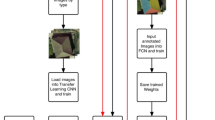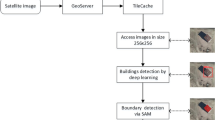Abstract
In a large variety of smart city applications, the processes are settled with LOD2 (Level of Details) and the generation of the LOD2 models requires the proper generation of the roof geometries. In general, obtaining roof type information and succeeding generations of the LOD2 models requires expensive aerial surveys and time-consuming construction processes. In this study, a methodology to generate LOD2 building models using only 2D building footprints and aerial imagery is explained to overcome these challenges. The roof type information has been obtained from an aerial image that covers the entire study area using a CNN (Convolutional Neural Network) model. Then, the roof geometries have been constructed procedurally by extending and implementing a well-known Straight Skeleton (SS) algorithm for three main types of roofs: flat, gable and hipped. These constructed roof geometries have been combined with LOD1 block models generated by extruding the 2D footprints according to the height attribute. The overall accuracy of the CNN is 89.9% and the class-wise accuracies are over 84% for all classes. The least recall value is observed for the gable roof class, the enhancement options are discussed in the relevant section. The proposed methodology has been developed as a web-based solution utilizing RESTful web services with modern web technologies. In summary, the main novelty of the study is based on two contributions: using DL for gathering roof-type information without any end-user interference and the extension of the SS algorithm for the construction of roof geometries. The final product of this study is a web-based architecture for the rapid generation of the LOD2 building models.















Similar content being viewed by others
Data availability
The data and code used in this study are available at https://github.com/alpertungakin/Roof-Type-Classification.
Notes
as used by Land registry Offices in Turkey.
References
Abadi M, Agarwal A, Barham P, Brevdo E, Chen Z, Citro C, Corrado GS, Davis A, Dean J, Devin M, Ghemawat S, Goodfellow I, Harp A, Irving G, Isard M, Jia Y, Jozefowicz R, Kaiser L, Kudlur M, Levenberg J, Man´e D, Monga, R, Moore S, Murray D, Olah C, Schuster M, Shlens J, Steiner B, Sutskever I, Talwar K, Tucker P, Vanhoucke V, Vasudevan V, Vi´egas F, Vinyals O, Warden P, Wattenberg M, Wicke M, Yu Y, Zheng X. (2015) TensorFlow: Large-Scale Machine Learning on Heterogeneous Systems. Software available from tensorflow.org. https://www.tensorflow.org/
Aichholzer O, Aurenhammer F, Alberts D, Gartner B (1996) A novel type of skeleton for polygons. In: J. UCS The Journal of Universal Computer Science, pp. 752–761
Alomía G, Loaiza D, Zúñiga C, Luo X, Asorey-Cacheda R (2021) Procedural modeling applied to the 3D city model of bogota: a case study. Virt Real Intell Hardw 3(5):423–433
Arroyo Ohori K, Ledoux H, Stoter J (2015) A dimension-independent extrusion algorithm using generalised maps. Int J Geogr Inf Sci 29(7):1166–1186
Axelsson M, Soderman U, Berg A, Lithen T (2018) Roof type classification using deep convolutional neural networks on low resolution photogrammetric point clouds from aerial imagery. In: 2018 IEEE International Conference on Acoustics, Speech and Signal Processing (ICASSP), pp. 1293–1297
Bauchet J-P, Lafarge F (2019) City reconstruction from airborne lidar: a computational geometry approach. In: 3D GeoInfo 2019–14th Conference 3D GeoInfo
Bengio Y, Goodfellow I, Courville A (2017) Deep Learning, vol 1. MIT press Cambridge, MA, USA
Biljecki F, Dehbi Y (2019) Raise the roof: Towards generating LOD2 models without aerial surveys using machine learning. ISPRS Annals Photogramm Remote Sens Spat Inf Sci 4:27–34
Biljecki F, Ledoux H, Stoter J (2017a) Does a finer level of detail of a 3d city model bring an improvement for estimating shadows? In: Advances in 3D Geoinformation, pp. 31–47
Biljecki F, Ledoux H, Stoter J (2017b) Generating 3d city models without elevation data. Comput Environ Urban Syst 64:1–18
Biljecki F, Ledoux H, Stoter J (2016) Generation of multi-LOD 3D city models in CityGML with the procedural modelling engine Random3Dcity. ISPRS Ann. Photogramm Remote Sens Spatial Inf Sci 3:51–59
Biljecki F, Stoter J, Ledoux H, Zlatanova S, Çöltekin A (2015) Applications of 3d city models: State of the art review. ISPRS Int J Geo Inf 4(4):2842–2889
Bradbury K, Brigman B, Collins L, Johnson T, Lin S, Newell R, Park S, Suresh S, Wiesner H, Xi Y (2016) Aerial imagery object identification dataset for building and road detection, and building height estimation. figshare
Buyukdemircioglu M, Kocaman S, Kada M (2022) Deep learning for 3D building reconstruction: A review. Int Arch Photogramm Remote Sens Spat Inf Sci, 359–366
Çağdaş V (2012)Taşınmaz Değerlemesi Ders Planı, https://slideplayer.biz.tr/amp/3151467/
Castagno J, Atkins EM (2018) Automatic classification of roof shapes for multicopter emergency landing site selection. In: 2018 Aviation Technology, Integration, and Operations Conference, p. 3977
Chen J, Li J, Li M (2016) Progressive visualization of complex 3D models over the internet. Trans GIS 20(6):887–902
Dehbi Y, Henn A, Gröger G, Stroh V, Plümer L (2021) Robust and fast reconstruction of complex roofs with active sampling from 3D point clouds. Trans GIS 25(1):112–133
Demir C, Koramaz TK (2018) GIS-based procedural modeling in contemporary urban planning practice. In 2018 22nd International Conference Information Visualisation (IV) (pp. 553–560). IEEE
Eppstein D, Erickson J (1999) Raising roofs, crashing cycles, and playing pool: Applications of a data structure for finding pairwise interactions. Discret Comput Geom 22(4):569–592
Felkel P, Obdrzalek S (1998) Straight skeleton implementation. In: Proceedings of Spring Conference on Computer Graphics. Citeseer
Huang, J. (2019) A 3D GIS-based valuation system for assessing the scenic view in residential property valuations
Kelly T (2014) Unwritten procedural modeling with the straight skeleton. PhD thesis, University of Glasgow
Kelly T (2021) CityEngine: an introduction to rule-based modeling. Urban informatics, 637–662
Khayyal HK, Zeidan ZM, Beshr AA (2022) Creation and spatial analysis of 3D city modeling based on GIS data. Civ Eng J 8(1):105
Ledoux H, Meijers M (2011) Topologically consistent 3d city models obtained by extrusion. Int J Geogr Inf Sci 25(4):557–574
Martinovic A (2015) Inverse procedural modeling of buildings
Nurkarim W, Wijayanto AW (2023) Building footprint extraction and counting on very high-resolution satellite imagery using object detection deep learning framework. Earth Sci Inf 16(1):515–532
Partovi T, Fraundorfer F, Bahmanyar R, Huang H, Reinartz P (2019) Automatic 3-d building model reconstruction from very high resolution stereo satellite imagery. Remote Sens 11(14):1660
Salvaris M, Dean D, Tok WH (2018) Cognitive services and custom vision. In: Deep Learning with Azure, pp. 99–128
Senyurdusev G, Dogru AO (2020) An Alternative Approach For Creating 3d City Model Using Procedural Modeling, In Proceedings of the 8th International Conference on Cartography and GIS, Nessebar, Bulgaria
Senyurdusev G, Dogru AO (2020) Ulugtekin, N. N. Exploring the opportunities of open source data use in creation 3d procedural city models. In Proceedings of the 8th International Conference on Cartography and GIS, Nessebar, Bulgaria (pp. 15–20)
Souvaine D (2005) Line segment intersection using a sweep line algorithm. Tufts University
Tekavec J, Lisec A, Rodrigues E (2020) Simulating Large-Scale 3D Cadastral Dataset Using Procedural Modelling. ISPRS Int J Geo Inf 9(10):598
Tomljenovic I, Höfle B, Tiede D, Blaschke T (2015) Building extraction from airborne laser scanning data: An analysis of the state of the art. Remote Sens 7(4):3826–3862
Tsiliakou E, Labropoulos T, Dimopoulou E (2014) Procedural modeling in 3d gis environment. Int J 3-D Inf Model (IJ3DIM) 3(3):17–34
URL-1: https://vc.systems/en/products/building-reconstruction/
URL-2: https://github.com/alpertungakin/Roof-Type-Classification
URL-3: https://www.resmigazete.gov.tr/eskiler/2018/05/20180520-4.htm
Weiler V, Stave J, Eicker U (2019) Renewable energy generation scenarios using 3d urban modeling tools—methodology for heat pump and co-generation systems with case study application. Energies 12(3):403
Welle Donker F, Van Loenen B, Bregt AK (2016) Open data and beyond. ISPRS Int J Geo Inf 5(4):48
Wendel J, Simons A, Nichersu A, Murshed SM (2017) Rapid development of semantic 3D city models for urban energy analysis based on free and open data sources and software. In Proceedings of the 3rd ACM SIGSPATIAL Workshop on Smart Cities and Urban Analytics (pp. 1–7)
Yang X, Delparte D (2022) A Procedural Modeling Approach for Ecosystem Services and Geodesign Visualization in Old Town Pocatello. Idaho Land 11(8):1228
Zhang M, Wu J, Liu Y, Zhang J, Li G (2022) GIS Based Procedural Modeling in 3D Urban Design. ISPRS Int J Geo Inf 11(10):531
Acknowledgements
We would like to express our sincere gratitude to the Scientific and Technological Research Council of Türkiye (TUBITAK) for their support, their assistance has been instrumental in enabling the successful completion of this study.
Funding
This work was supported by The Scientific And Technological Research Council Of Türkiye (TUBITAK) with the grant ID of 118Y452.
Author information
Authors and Affiliations
Contributions
Ziya Usta and Alper Tunga Akın performed algorithmic development stages and prepared figures. Ziya Usta, Alper Tunga Akın and Çetin Cömert wrote the main article text.
Corresponding author
Ethics declarations
Competing interests
The authors have no competing interests to declare that are relevant to the content of this article.
Consent for publication
If the article is accepted by the Editor-in-chief after the review process, all authors consent to the manuscript being published in Earth Science Informatics. The work did not include human participants in order to obtain their consent.
Additional information
Communicated by: H. Babaie
Publisher's note
Springer Nature remains neutral with regard to jurisdictional claims in published maps and institutional affiliations.
Rights and permissions
Springer Nature or its licensor (e.g. a society or other partner) holds exclusive rights to this article under a publishing agreement with the author(s) or other rightsholder(s); author self-archiving of the accepted manuscript version of this article is solely governed by the terms of such publishing agreement and applicable law.
About this article
Cite this article
Usta, Z., Akın, A.T. & Cömert, Ç. Deep learning aided web-based procedural modelling of LOD2 city models. Earth Sci Inform 16, 2559–2571 (2023). https://doi.org/10.1007/s12145-023-01053-0
Received:
Accepted:
Published:
Issue Date:
DOI: https://doi.org/10.1007/s12145-023-01053-0




